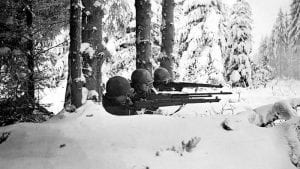 In Slaughterhouse-Five, I’ve noticed that Kurt Vonnegut has a very unique means of storytelling. The story follows the life and experiences of Billy Pilgrim, an American soldier during the Battle of the Bulge (1944). There’s a twist however: Billy has become “unstuck” in time. This means that at any point he could suddenly jump to another part of his life. Vonnegut uses this plot point in order to give the reader a piece of information about Billy’s past or future before jumping back to his time in the war.
In Slaughterhouse-Five, I’ve noticed that Kurt Vonnegut has a very unique means of storytelling. The story follows the life and experiences of Billy Pilgrim, an American soldier during the Battle of the Bulge (1944). There’s a twist however: Billy has become “unstuck” in time. This means that at any point he could suddenly jump to another part of his life. Vonnegut uses this plot point in order to give the reader a piece of information about Billy’s past or future before jumping back to his time in the war.
I find this format to be extremely effective. It characterizes Billy in a far more efficient manner than would be accomplished by simply characterizing him in the present, since the reader is shown a wider scope of Billy’s life. This format also aids the pacing of the story. Because of the periodical switch between the past/future and the present, neither part hangs around long enough to become stale. This is why I’ve yet to reach a part in the book that feels slow or tiresome. I hope to see this style continue throughout the rest of the novel.
 egan reading the book “Slaughterhouse-Five” by Kurt Vonnegut. I haven’t read too much of it but based off what I have read, the tone is what sticks out the most to me. This book is supposed to be about the firebombing of Dresden late in WWII, where 135,000 Germans lost their lives. Despite this, the author keeps up an ironic half-joking tone, almost akin to dark humour. For example, he shares a personal story of how he planned out the story on the back of a roll of wallpaper using his “daughter’s crayons, a different color for each main character. One end of the wallpaper was the beginning of the story , and the other end was the end”. Each character was then represented by a line. “The destruction of Dresden was represented by a vertical band of orange cross-hatching, and all the lines that were still alive passed through it, came out the other side”
egan reading the book “Slaughterhouse-Five” by Kurt Vonnegut. I haven’t read too much of it but based off what I have read, the tone is what sticks out the most to me. This book is supposed to be about the firebombing of Dresden late in WWII, where 135,000 Germans lost their lives. Despite this, the author keeps up an ironic half-joking tone, almost akin to dark humour. For example, he shares a personal story of how he planned out the story on the back of a roll of wallpaper using his “daughter’s crayons, a different color for each main character. One end of the wallpaper was the beginning of the story , and the other end was the end”. Each character was then represented by a line. “The destruction of Dresden was represented by a vertical band of orange cross-hatching, and all the lines that were still alive passed through it, came out the other side”